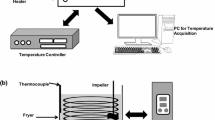Abstract
Fried foods are frequently served by fast food establishments but the evaluation of the oil used is quite laborious, expensive, and requires a well-structured laboratory with sophisticated equipment. Moreover, p-anisidine, used as the reagent in the traditional test for monitoring the alkenal concentration of frying oils, is carcinogenic. The DiaMed F.A.T.S. kits for the determination of alkenal (AlkalSafe™ STD) and malonaldehyde (AldelSafe™ STD), equivalent to the p-anisidine and TBA tests, respectively, are safe, fast and accurate, using compact equipment and generating fewer residues than the official methods. The results obtained using these kits were compared with those obtained using the official methods for determining alkenal (AOCS Cd 18b-90) and malonaldehyde (AOCS Cd 19b-90), in 20 samples collected from an institutional restaurant. Based on the least squares regression analysis, the AlkalSafe kit results were highly correlated with the p-anisidine values (r = 0.74), but there was a lack of correlation between the results of the AldeSafe™ kit and the TBA test. Both kits were significantly more sensitive than the official methods, as revealed by the results of the Tukey test. Although the TBA values for the samples investigated were minimal, suggesting the inadequacy of the test for monitoring frying oils, the greater sensitivity of the kit makes it a relatively feasible option.

Similar content being viewed by others
References
Gertz C (2000) Deep frying remains an art. Eur J Lipid Sci Technol 102:529–538
Dobarganes MC, Márquez-Ruiz G (1998) Regulation of used frying fats and validity of quick tests for discarding the fats. Grasas y Aceites 48:331–335
Paul S, Mittal GS (1997) Regulating the use of degraded oil/fat in deep-fat/oil food frying. Crit Rev Food Sci Nutr 37:635–662
AOCS (2004) Official methods and recommended practices of the American Oil Chemists’ Society. AOCS, Champaign
Houhoula DP, Oreopoulou V, Tzia C (2002) A kinetic study of oil deterioration during frying and a comparison with heating. J Am Oil Chem Soc 79:133–137
Tompkins C, Perkins EG (1999) The evaluation of frying oils with the p-anisidine value. J Am Oil Chem Soc 76:945–947
Lima JR, Gonçalves LAG (1994) Parâmetros de Avaliação da Qualidade de Óleo de Soja Utilizado para Fritura. Quím Nova 17:392–396
Rossell JB (1994) Measurement of rancidity, In: Allen JC, Hamilton RJ (eds) Rancidity in Foods, Chapman and Hall, London, pp 22–53
Przybylski R, Eskin NAM (1999) Measurement and significance of volatile compounds, In: Warner K, and Eskin NAM (eds) Methods to assess quality and stability of oils and fat-containing foods, AOCS, Champaign, 1995, pp 107–133 apud Tompkins C, Perkins EG (1999) The evaluation of frying oils with the p-anisidine value. J Am Oil Chem Soc 76:945–947
Addis PB (1986) Occurrence of lipid oxidation products in foods. Food Chem Toxicol 24:1021–1030
Osawa CC, de Felicio PE, Gonçalves LAG (2005) Teste de TBA aplicado a carnes e derivados: métodos tradicionais, modificados e alternatives. Quím Nova 28:655–663
DGF (1984) Deutsche Einheitsmethoden zur Untersuchung von Fetten, Fettprodukten und verwandten Stoffen. Wis-senschaftliche Verlagsgesellschaft mbH, Münster
Naz S, Siddiqi R, Sheikh H, Sayeed SA (2005) Deterioration of olive, corn and soybean oils due to air, light, heat and deep-frying. Food Res Int 38:127–134
Chu YH (1991) A comparative study of analytical methods for evaluation of soybean oil quality. J Am Oil Chem Soc 68:379–384
Man YBC, Liu JL, Jamilah B, Rahman RA (1999) Quality changes of refined-bleached-deodorized (RBD) palm olein, soybean oil and their blends during deep-fat frying. J Food Lipids 6:181–193
List GR, Evans CD, Kwolek WF, Warner K, Boundy BK, Cowan JC (1974) Oxidation and quality of soybean oil: a preliminary study of the anisidine test. J Am Oil Chem Soc 51:18–21
Tan CP, Che-Man YB, Selamat J, Yusoff MSA (2002) Comparative studies of oxidative stability of edible oils by differential scanning calorimetry and oxidative stability index methods. Food Chem 76:385–389
Medina-Juarez LA, Gonzalez-Diaz P, Gamez-Meza N, Ortega-Garcia J, Moreno-Varela AB, Bringas-Alvarado L, Angulo-Guerrero O (1998) Effects of processing on the oxidative stability of soybean oil produced in México. J Am Oil Chem Soc 75:1729–1733
Gil B, Cho YJ, Yoon SH (2004) Rapid determination of polar compounds in frying fats and oils using image analysis. Lebensm Wiss Technol 37:657–661
Al-Kahtani H (1991) Survey of quality of used frying oils from restaurants. J Am Oil Chem Soc 68:857–862
Acknowledgments
The authors are grateful to Capes and DiaMed AG (Switzerland) for their financial support, Mr. Laércio de Melo for his active participation, Mrs. Evelyne de Groote for technical assistance and Mr. José Togashi who gave permission to collect the frying oil from the Institutional Restaurant of Unicamp.
Author information
Authors and Affiliations
Corresponding author
About this article
Cite this article
Osawa, C.C., Gonçalves, L.A.G. & Ragazzi, S. The Use of Fast Methodologies (Kits) in Evaluating Deep-Frying Oils. J Am Oil Chem Soc 84, 893–897 (2007). https://doi.org/10.1007/s11746-007-1124-7
Received:
Revised:
Accepted:
Published:
Issue Date:
DOI: https://doi.org/10.1007/s11746-007-1124-7




